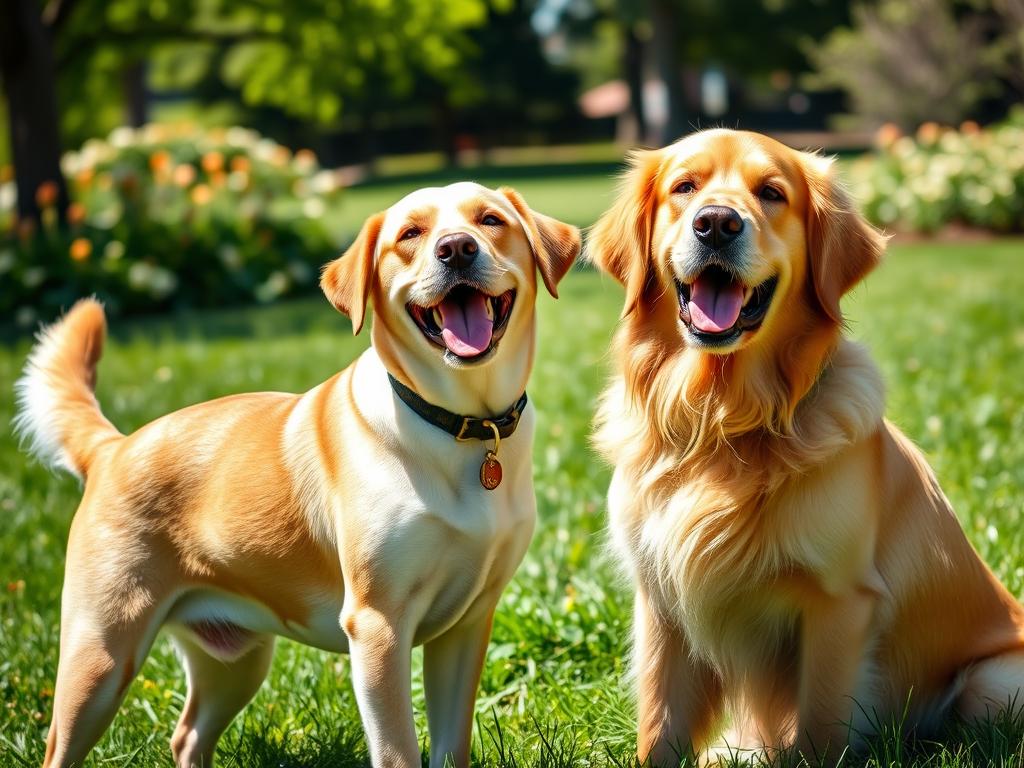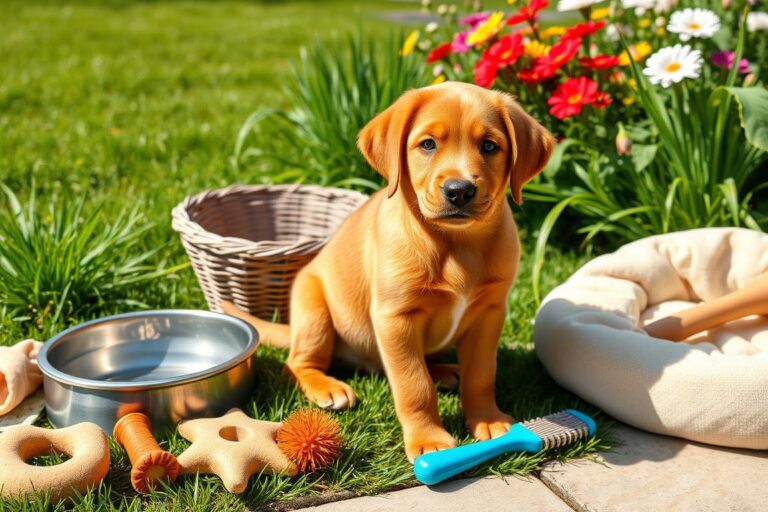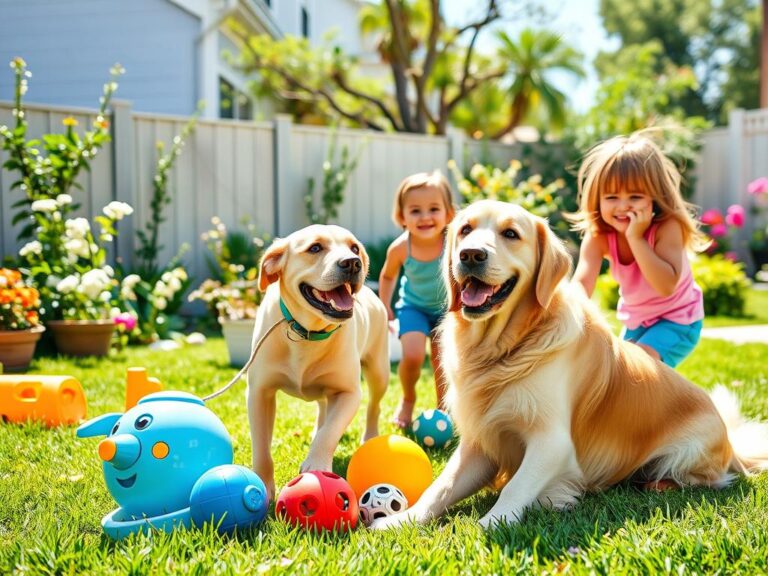Best Dog to Breed with Labrador: Top Mixes Guide
Welcome to your guide on the best dog to breed with a Labrador Retriever. Labradors are loved for their friendly nature and smartness. They have been America’s favorite dog for nearly 30 years.
If you’re thinking about breeding or just love dogs, you might want to look into Labrador cross breeds. Each mix brings special traits that make Labradors even more loving and friendly. This article will show you the most popular mixes and what makes them special.
From the beloved Goldador to the unique Labradoodle, there are many ways to create loving pets. These dogs can bring joy and companionship into your life.
Understanding the Labrador Retriever
The Labrador Retriever is known for being friendly and hardworking. They come from early 19th-century Newfoundland. There, they helped fishermen by picking up fish and nets.
They are related to the St. John’s dog. This helped shape the breed we love today. Now, Labradors are popular in families because of their friendly and energetic nature.
History of the Labrador Retriever
The breed started in Newfoundland’s fishing communities. They helped with fishing, like pulling in nets. Later, they went to England and were improved.
Now, Labradors are known for being smart and versatile. They are great as pets, service dogs, and search-and-rescue dogs.
Temperament of Labradors
Labradors are friendly and outgoing. They get along well with kids and other pets. This makes them a good fit for many homes.
They love to play and need lots of exercise. This keeps them happy and healthy. They are also easy to train because they want to please.
Health Characteristics
It’s important to know about Labradors’ health. They can get hip dysplasia, elbow dysplasia, and progressive retinal atrophy. Regular vet visits and health tests are key.
Keeping your dog healthy means watching their weight and exercising them. This helps avoid health problems.
| Health Issue | Description | Prevention |
|---|---|---|
| Hip Dysplasia | Genetic disorder affecting hip joints. | Regular veterinary check-ups and maintaining a healthy weight. |
| Elbow Dysplasia | Growth abnormalities in elbow joints. | Screening with OFA tests and proper nutrition. |
| Progressive Retinal Atrophy | Gradual degeneration of retinal cells. | Regular screenings and discussing genetic testing options. |
Benefits of Breeding with Labrador
Breeding with Labradors has many benefits. They are great for families and can live in many places. They are popular in the United States because of their good traits.
Friendly Nature of Labradors
Labradors are very friendly. They are perfect for families with kids. They get along well with other pets and people.
Versatility and Adaptability
Labradors can live in many places. They have lots of energy for fun activities. They are good for singles and families in homes or apartments.
Family-Friendly Traits
Labradors are great for families. They are patient, loyal, and love to join in family fun. This makes them a popular choice for families.
Top Breeds to Mix with Labrador
Labrador mixes are very popular. They mix well with many breeds, like Golden Retrievers, Poodles, and Beagles. These mixes bring unique traits that many people love.
Golden Retriever
The Golden Retriever is a great match for Labradors. They make the friendly Goldador. Goldadors are smart and love families.
They weigh 55 to 80 pounds and live 10 to 12 years. They are great with kids and active families.
Poodle
Poodles are a good mix for Labradors. They create the playful Labradoodle. Labradoodles are low-shedding and can live up to 18 years.
They need regular grooming to keep their curly coat nice. This makes them a top choice for families who want a low-shedding pet.
Beagle
Beagles and Labradors make the fun Beagador. Beagadors are playful and friendly. They love to be active.
They are loyal and loving. Their energy makes them perfect for active families.
Golden Retriever and Labrador Mix
The Goldador is a mix of a Golden Retriever and a Labrador Retriever. They are friendly, smart, and great friends for families and people. Knowing what makes a Goldador special is key for owners.
Characteristics of Goldadors
Goldadors weigh 60-80 pounds and are 22 to 24 inches tall. Their fur can be many colors like golden, cream, and black. They smell well and remember things well. They need 45 minutes of play each day.
Health Considerations
Goldadors might get sick like their parents. They can have joint problems and get too fat. It’s important to check their health often. This helps them live a long and healthy life.
Ideal Living Conditions
Goldadors like different homes. They need space to play, but they can live in small or big places. A yard or park is good for them. They love being around people.

| Attribute | Details |
|---|---|
| Weight | 60-80 pounds |
| Height | 22-24 inches |
| Lifespan | 10-15 years |
| Exercise Needs | 45 minutes daily |
| Coat Colors | Light to dark golden, cream, yellow, black, chocolate/brown |
| Food Requirements | 2-3 cups of dry food per day |
| Grooming Frequency | Brush 2-3 times a week |
Poodle and Labrador Mix
Labradoodles are very popular as a mixed breed. They have special traits that many people like. Knowing what makes them great can help you decide if they’re right for you.
Benefits of Labradoodles
Labradoodles are friendly and love to be around people. They are the right size for many homes. They are also very smart and can learn many things.
They make great family pets and can even help people feel better. Their intelligence lets them be service dogs too.
Grooming Needs
Labradoodles need regular grooming. They can have curly, wavy, or straight fur. Depending on their fur, they might need a groomer every month.
Brushing them often can help with shedding. This makes them a good choice for families with allergies. But, they’re not completely allergy-free.
Personality Traits
Labradoodles are loving, smart, and full of energy. They need lots of playtime and exercise. They should get at least an hour of activity each day.
It’s important to socialize them early. This helps them not be scared and behave well. With training, they can fit in well with your family and adapt to new places.
Beagle and Labrador Mix
The Beagle and Labrador mix is called the Beagador. It’s a loyal and friendly dog. Knowing about beagador traits helps owners understand their pets better.
Beagadors are playful and loving. They make great pets for families. They love to play and be with their family.
Beagador Traits
Beagadors are smart and love to please. They are loving and playful, thanks to their beagle side. Their Labrador side makes them loyal and eager.
They are great with families. They bring joy and companionship. Beagadors are lively and can be different sizes.
Training Challenges
Training beagle lab mixes can be fun but hard. Beagles are independent, making training tough. But, with patience and positive methods, they learn well.
It’s important to be consistent and use positive methods. This helps them become good dogs.
Exercise Requirements
Beagadors need lots of exercise to stay happy and healthy. They need at least 60 minutes of activity every day. This can be walks, playtime, or biking.
Regular exercise stops bad behaviors from boredom or too much energy. It keeps them fit and happy for 10 to 12 years.
Factors to Consider Before Breeding
Before you start breeding Labradors, think about a few key things. The breeds you choose must be a good match. This ensures the puppies are healthy and of high quality.
Compatibility of Breeds
It’s vital to check if the breeds are compatible. Look at their temperaments, sizes, and health issues. Mixing big and small breeds can cause big problems during pregnancy.
Knowing each breed’s special traits helps make better choices. This way, you care for both the parents and the puppies.
Health Screenings
Health tests for both parents are a must. They help avoid genetic problems like cleft palates or disabilities. The American Kennel Club says genetic testing is key to good breeding.
This helps puppies grow up healthy and happy.
Responsible Breeding Practices
Good breeding means thinking about the puppies’ future. Breeders should know about inherited traits to avoid bad ones. A good stud service covers everything from mating to aftercare.
Having a stud contract is also important. It sets clear rules for both sides. This way, puppies go to the right homes and get the care they need.
Preparing for a New Litter
Getting ready for a new litter of puppies needs careful planning. It’s important to think about the mother’s health and the puppies’ needs. Knowing when to breed, what food to give, and setting up a good whelping area are key steps.
Ideal Age for Breeding
The best time to breed Labradors is between 2 to 5 years old. Health tests, like OFA checks, start when they’re two. Labradors usually get smart enough to breed around age 3.
Nutritional Needs During Pregnancy
Pregnant labs need more nutrients. A good diet helps the mom and the babies grow well. Choosing the right food is important for the puppies’ health later on.
Choosing a Whelping Area
A good whelping area is crucial for a smooth birth. It should be safe, quiet, and comfy. This lets the mom feel safe and helps the puppies too.
Raising Puppies from a Labrador Mix
Raising labrador mix puppies needs careful steps for their growth. Early socialization is key to their adaptability and behavior. Exposing them to different places and people helps them grow well-adjusted.
Socialization Tips
Socialization is vital for a puppy’s growth. Introduce your Labrador mix to people, pets, and places early. Short walks and visits to parks and playdates with dogs boost their confidence.
Make these experiences fun with rewards and praise. This helps build their social skills.
Basic Training Techniques
Positive reinforcement works well for training labrador mix puppies. Teach them basic commands like ‘sit,’ ‘stay,’ and ‘come.’ Keep training short and fun to keep them interested.
Adding fun activities like agility games engages their intelligence. This makes learning a joy.
Health Checkups and Vaccinations
Don’t forget about your puppy’s health care. Regular vet visits are crucial for monitoring growth and vaccinations. Vaccines prevent illnesses, especially for dogs with inherited health risks.
| Mix Breed | Common Health Issues | Training Tips | Socialization Needs |
|---|---|---|---|
| Afador | Medium to long fur grooming | Positive reinforcement | Daily exposure to new situations |
| Bassador | Mobility issues | Gentle training methods | Encouragement to walk |
| Cavadors | Heart issues | Consistent commands | Interaction with different pets |
| Goldador | None specific | Interactive games | Frequent family outings |
| Labernese | Potential nervousness | Calm and positive guidance | Exposure to crowds |
| Labradoodle | Frequent grooming needed | Engaging training sessions | Social gatherings |
Potential Health Concerns in Crossbreeds
Thinking about a Labrador mix? Know about health issues they might face. Mixed breeds can get good traits but also health problems from their parents. Issues like hip dysplasia, eye problems, and geriatric-onset laryngeal paralysis are common. Knowing these risks helps you prepare for health challenges.
Common Genetic Issues
Genetic problems in crossbreeds come from their parents. Some hybrid dogs face higher risks of certain diseases. For example, Labradoodles and Cockapoos often get ear infections. Cockapoos also get itchy skin from allergies.
This shows why it’s key to research both breeds’ health before breeding.
Regular Health Assessments
Regular health checks are key for lab mixes. They help find problems early. This way, you can act fast. Since crossbreeds can get health issues from both parents, seeing the vet often is important.
Your vet can suggest tests based on your dog’s background.
Vet Recommendations
Talking to a vet is very important for lab mixes. They can tell you about possible health issues and suggest tests. Good breeders check their dogs for diseases like hip dysplasia and cataracts.
Following these steps helps make healthy puppies and reduces health risks.
Finding Good Homes for Puppies
When we find homes for Labrador mix puppies, we want them to be happy and safe. We start by checking if the new owners are ready to care for a pet. We ask them questions to see if they understand the costs and commitment of dog care.
Screening Potential Owners
We talk to people who want to adopt puppies to make sure they’re a good fit. It’s important to check their references and who they are. We also make sure they agree to spay or neuter their puppy to stop irresponsible breeding.
Providing Support After Adoption
Helping new owners after they adopt is key. We teach them how to train and care for their puppy. This helps them feel confident and ready to take care of their new pet.
Keeping in Touch with New Families
It’s good to stay in touch with the new owners. We check how the puppy is doing in their new home. This helps us improve our breeding and makes sure everyone is happy.
Concluding Thoughts on Breeding Labradors
Thinking about Labrador breeding is a chance to help the breed grow. It’s important to think about the good and hard parts of breeding Labradors. You must always put your puppies’ health first.
Labrador mixes are special because they are friendly and can help make healthier dogs. Doing health checks and breeding right helps. This way, fewer dogs need to be rehomed.
Labrador mixes bring happiness with their fun nature. When you breed right, you make friends for life. You also make sure each dog is happy and healthy forever.
It’s key to care for mixed breed dogs all their lives. This means doing health tests, knowing about health problems, and helping families with your puppies. By doing this, you help dogs find good homes and stop overpopulation.







